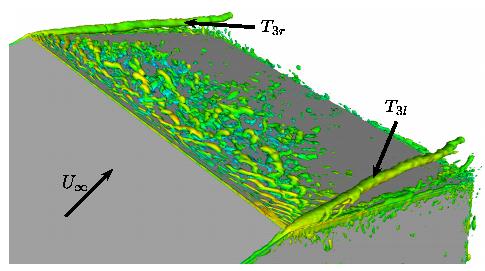 |
FLOMANIA
|
| Coordinator: |
Dr. W. Haase, EADS - Military Aircraft werner.haase@m.eads.net |
| Supervisor (Chalmers): |
Lars Davidson lada@chalmers.se |
| Researchers at Chalmers: |
S. Dahlström lada@chalmers.se S. Krajnovic sinisa@chalmers.se |
| Publications: | [1-11] |
| Start of project: | January 2002 |
| End of project: | September 2004 |
OBJECTIVES OF THE PROJECT The project is considered to be a unique attempt to group the best experts in research and CFD developers in Europe, in order to transfer their advanced knowledge to the aeronautical industry in a controlled, objective oriented way. For detailed information, klick here. CHALMERS' CONTRIBUTION The main effort of Chalmers will be directed towards LES, unsteady RANS and hybrid LES-RANS. Chalmers has developed a hybrid (zonal) LES-RANS model (Davidson & Peng, 2003). Unsteady RANS is performed in the near-wall regions (y+ < 60) employing a two-equation k-omega model, and LES is carried out in the remaining of the flow domain emplying a one-equation SGS model. There are some unresolved problems concerning the matching between the two zones. One of the weaknesses in hybrid LES-RANS lies in the interface condition the LES region gets from the RANS region. The resolved turbulence supplied by the RANS region to the LES region does not have any reasonable turbulent characteristics: the resolved turbulent time and length scales of the unsteady RANS flow are not representative of the real turbulence at all. A remedy is to at the interface superimpose fluctuations at the LES side of the interface. These fluctuations should correspond to the gradient of the shear stress. The turbulent fluctuations can be taken from a DNS of a generic boundary layer, from synthetic turbulence (the turbulence is generated in wavenumber space) or from a vortex model. In this way, the LES region gets real turbulent flow from the RANS region with proper turbulent length and time scales. This approach has in the Flomania project been validated in fully developed channel flow and the flow in a asymmetric plane diffuser. The fluctuations were generated by a DNS. The results are very good. The flow around generic car shape, the Ahmed body with rear body slant angle of 25 degrees, is one test case in the project. This slant angle is close to the critical angle of 30 degree at which a shift in the topology of the wake occurs. The flow on the slant surface contains a very small and unsteady recirculation region. Thus the flow is extremely difficult to model and no RANS turbulence model is likely to be able to predict this flow. Although the Reynolds number of this flow is Re=768000 based on the height of the body, we simulated the flow at Re=200000 assuming that the flow is only weakly Reynolds number dependent. We have obtained results which are in very good agreement with experimental data, suggesting that our assumption is correct. REFERENCES
|
|
|
|
|
|
This page, Flow Physics Modelling: An Integrated Approach (flomania), should be part of a frames system at www.tfd.chalmers.se/~lada/projects/proind.html by Webmaster: Ingalena Ljungström ilj@flowsim.se |
|